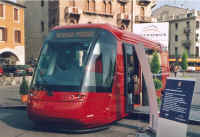

The most modern Italian tramway system is Messina, inaugurated on 3rd April 2003. A FIAT six-axle Cityway is running on a grass track section on the new 28 route. Photo © Francesco Bloisi.
Today in Italy there are ten tramway systems in service in eight different urban areas: Genova, Torino, Milano, Trieste, Roma, Napoli and Messina. We have conventional urban tramway or light rail networks (Torino, Milano, Roma, Napoli, Messina), rack tramways (Genova and Torino), interurban lines (Milano – Desio and Milano – Limbiate), a tramway/funicular mixed service (Trieste – Opicina), a residual of a long interurban line (Roma – Pantano). There are five different gauges: 1445 mm (Torino, Milano, Roma), 1435 mm (Napoli and Messina), 1200 mm (Genova), 1000 mm (Trieste – Opicina), 950 mm (Roma – Pantano).
Other systems in other areas are in building: Bergamo – Alzano interurban light rail (gauge 1435 mm), rubber-tired Padova system, Sassari light rail (gauge 950 mm).
 |
The moch-up of Clermont-Ferrand (France) Translohr rubber-tired tram was showed in Padova in Prato della Valle in occasion of the inauguration of first line's works. March 29th 2003. |
Metro lines are in service in five cities: Genova has a light metro line, while Milano, Roma, Napoli and Catania have heavy metro systems. I call light metros these lines with metro characteristic and run by vehicles more similar to trams than to metro trains, like, for example, U6 line in Wien.
|
The light metro in Genova, called Metrogenova. 03, a six-axle articulated tram-like car, is stopping in Brin ready to run to San Giorgio. August 2003. Photo © Alessio Pedretti. |
Two systems are in building: the first Torino automatic metro line with rubber-tired trains and the light metro line in Napoli.
In the following two tables I listed all the Italian tramway and the metro systems in services and in building. Some datum isn't exact and some other is missing. If you have more precise data, you can write me. The key of the "service" column is: U: urban service; S: suburban service; I: interurban service.
|
Systems in services |
||||||||||
|---|---|---|---|---|---|---|---|---|---|---|
| City/Line | Company | System | Service | Gauge | Routes/Lines | Lenght | Voltage | Opening | Notes | Map |
| Catania | FCE | Metro | U | 1435 mm | 1 | 4 km | 3000 V | 1999 | – | – |
| Genova | AMT | Light metro | U | 1435 mm | 1 | 5 km | 750 V | 1990 | 1 | – |
| Rack tramway | U | 1200 mm | 1 | 1 km | 600 V | 1901 | – | – | ||
| Messina | ATM (Messina) | Light rail | U | 1435 mm | 1 | 7 km | 750 V | 2003 | 2 | – |
| Milano | ATM (Milano) | Metro | U, S, I | 1435 mm | 3 | 69 km | 1500 V | 1964 | 1, 3 | – |
| Tramway Light rail |
U, S | 1445 mm | 17 | 168 km | 600 V | 1862 | 1 | Yes | ||
| Milano – Desio / Limbiate | Tramway | I | 1445 mm | 2 | 29 km | 600 V | 1881 | – | Yes | |
| Napoli | MN | Metro | U | 1435 mm | 1 | 9 km | 1500 V | 1993 | – | – |
| ANM | Tramway | U | 1435 mm | 3 | ~ 12 km | 600 V | 1875 | 4 | – | |
| Roma | ATAC | Tramway Light rail |
U | 1445 mm | 6 | 66 km | 600 V | 1882 | – | – |
| MetRo | Metro | U | 1435 mm | 2 | 33 km | 1500 V | 1955 | 1 | – | |
| Roma – Pantano | Light rail | S | 950 mm | 1 | 19 km | 1650 V | 1916 | – | – | |
| Torino | ATM (Torino) | Tramway Light rail |
U | 1445 mm | 8 | ~ 110 km | 600 V | 1872 | 4 | – |
| Torino – Superga | Rack tramway | S | 1445 mm | 1 | 3 km | 600 V | 1884 | – | – | |
| Trieste – Opicina | ACT | Tramway with a funicular section | I | 1000 mm | 1 | 5 km | 600 V | 1902 | – | – |
|
Notes |
|
|||||||||
|
Systems in building |
||||||||||
|---|---|---|---|---|---|---|---|---|---|---|
| City/Line | Company | System | Service | Gauge | Routes/Lines | Lenght | Voltage | Opening | Notes | Map |
| Bergamo – Alzano | TB | Light rail | I | 1435 mm | 1 | ? | 750 V ? | ? | 1 | – |
| Napoli | ANM | Light metro | U | 1435 mm | 1 | ? | 750 V | ? | – | – |
| Padova | APS | Rubber-tired tramway | U | - | 1 | 10 km | 750 V ? | 2004 | 2 | – |
| Sassari | FdS | Light rail | U | 950 mm | 1 | 3 km | 750 V | 2004 | – | – |
| Torino | ATM (Torino) | Automatic rubber-tired metro | U | 1435 mm | 1 | 10 km | 750 V ? | 2005 | – | – |
| Notes |
|
|||||||||
© 2003 Ivan Furlanis
Last changes: October 2003